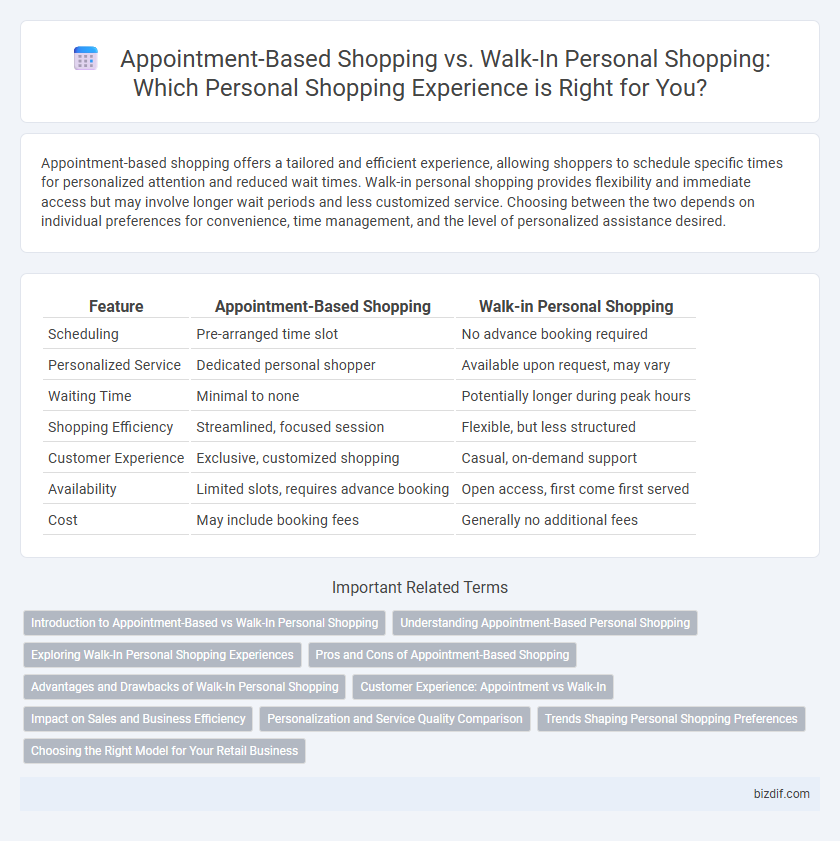Appointment-based shopping offers a tailored and efficient experience, allowing shoppers to schedule specific times for personalized attention and reduced wait times. Walk-in personal shopping provides flexibility and immediate access but may involve longer wait periods and less customized service. Choosing between the two depends on individual preferences for convenience, time management, and the level of personalized assistance desired.
Table of Comparison
| Feature | Appointment-Based Shopping | Walk-in Personal Shopping |
|---|---|---|
| Scheduling | Pre-arranged time slot | No advance booking required |
| Personalized Service | Dedicated personal shopper | Available upon request, may vary |
| Waiting Time | Minimal to none | Potentially longer during peak hours |
| Shopping Efficiency | Streamlined, focused session | Flexible, but less structured |
| Customer Experience | Exclusive, customized shopping | Casual, on-demand support |
| Availability | Limited slots, requires advance booking | Open access, first come first served |
| Cost | May include booking fees | Generally no additional fees |
Introduction to Appointment-Based vs Walk-In Personal Shopping
Appointment-based personal shopping offers a tailored experience with dedicated time slots, ensuring personalized attention and curated selections suited to individual preferences. Walk-in personal shopping provides flexibility and spontaneity, allowing customers to browse and consult with stylists without prior scheduling. Both methods enhance customer engagement, but appointment-based shopping optimizes service efficiency and personalized styling.
Understanding Appointment-Based Personal Shopping
Appointment-based personal shopping offers a tailored experience by scheduling dedicated time with a stylist, ensuring personalized attention and curated selections based on individual preferences. This method reduces wait times and enables more in-depth consultation, often resulting in higher customer satisfaction and efficient shopping trips. Retailers benefit from predicting customer flow and optimizing inventory, which contrasts with the unpredictability and potential crowding of walk-in personal shopping.
Exploring Walk-In Personal Shopping Experiences
Walk-in personal shopping offers immediate, flexible access to expert assistance without the need for prior booking, enhancing convenience for spontaneous shoppers. Retailers provide personalized style advice and product recommendations on the spot, utilizing real-time inventory to meet individual preferences efficiently. This approach fosters a dynamic shopping experience, combining personalized service with the freedom to explore at one's own pace.
Pros and Cons of Appointment-Based Shopping
Appointment-based shopping offers personalized service and dedicated time slots, ensuring a tailored and efficient experience with less crowding and wait time. However, it requires prior planning and commitment, which may limit spontaneity and flexibility for shoppers. This method enhances customer satisfaction through focused attention but can be less accessible to those seeking immediate purchases.
Advantages and Drawbacks of Walk-In Personal Shopping
Walk-in personal shopping offers immediate access to assistance without the need for prior scheduling, providing convenience for spontaneous shoppers. This approach allows customers to browse freely while receiving expert advice, enhancing the overall shopping experience. However, the lack of appointment may lead to longer wait times and limited availability of personal shoppers during peak hours, potentially reducing the quality of personalized service.
Customer Experience: Appointment vs Walk-In
Appointment-based personal shopping offers a customized and focused customer experience, allowing shoppers to schedule dedicated time with experts who tailor selections to individual preferences. Walk-in personal shopping provides flexibility and immediacy, catering to spontaneous visits and quick assistance without prior booking. Customers seeking personalized attention and minimized wait times benefit most from appointment-based services, while walk-ins enjoy convenient, on-demand access to personal shoppers.
Impact on Sales and Business Efficiency
Appointment-based personal shopping enhances sales by allowing retailers to allocate dedicated time and resources for each customer, resulting in tailored assistance and higher conversion rates. Walk-in personal shopping offers convenience and spontaneity, potentially increasing foot traffic but often leads to inconsistent staffing and variable service quality. Businesses adopting appointment-based models experience improved operational efficiency through better scheduling and inventory management, while walk-in services may struggle with peak-time overcrowding and resource misallocation.
Personalization and Service Quality Comparison
Appointment-based shopping offers a tailored experience with dedicated time slots, ensuring personalized attention and a deeper understanding of customer preferences for more accurate product recommendations. Walk-in personal shopping provides spontaneous access but may lead to limited personalized service and shorter interactions due to unpredictable customer flow. Service quality in appointment settings typically excels due to focused customer-consultant engagement, enhancing satisfaction and loyalty.
Trends Shaping Personal Shopping Preferences
Appointment-based personal shopping offers a tailored experience with dedicated time slots, allowing shoppers to receive personalized attention and product recommendations, which has surged in popularity due to increasing demand for convenience and exclusivity. Walk-in personal shopping remains favored for its spontaneity and flexibility, catering to customers seeking immediate, unplanned retail assistance without prior scheduling. Current trends show a growing preference for hybrid models integrating both appointment-based and walk-in options, driven by evolving consumer expectations for personalized yet accessible shopping experiences.
Choosing the Right Model for Your Retail Business
Appointment-based personal shopping offers retailers a structured approach to managing customer flow, allowing for personalized service and efficient staff allocation. Walk-in personal shopping caters to spontaneous shoppers, increasing accessibility but potentially causing service delays during peak times. Selecting the right model depends on your retail business goals, customer demographics, and capacity to deliver tailored shopping experiences without compromising operational efficiency.
Appointment-based shopping vs Walk-in personal shopping Infographic

 bizdif.com
bizdif.com